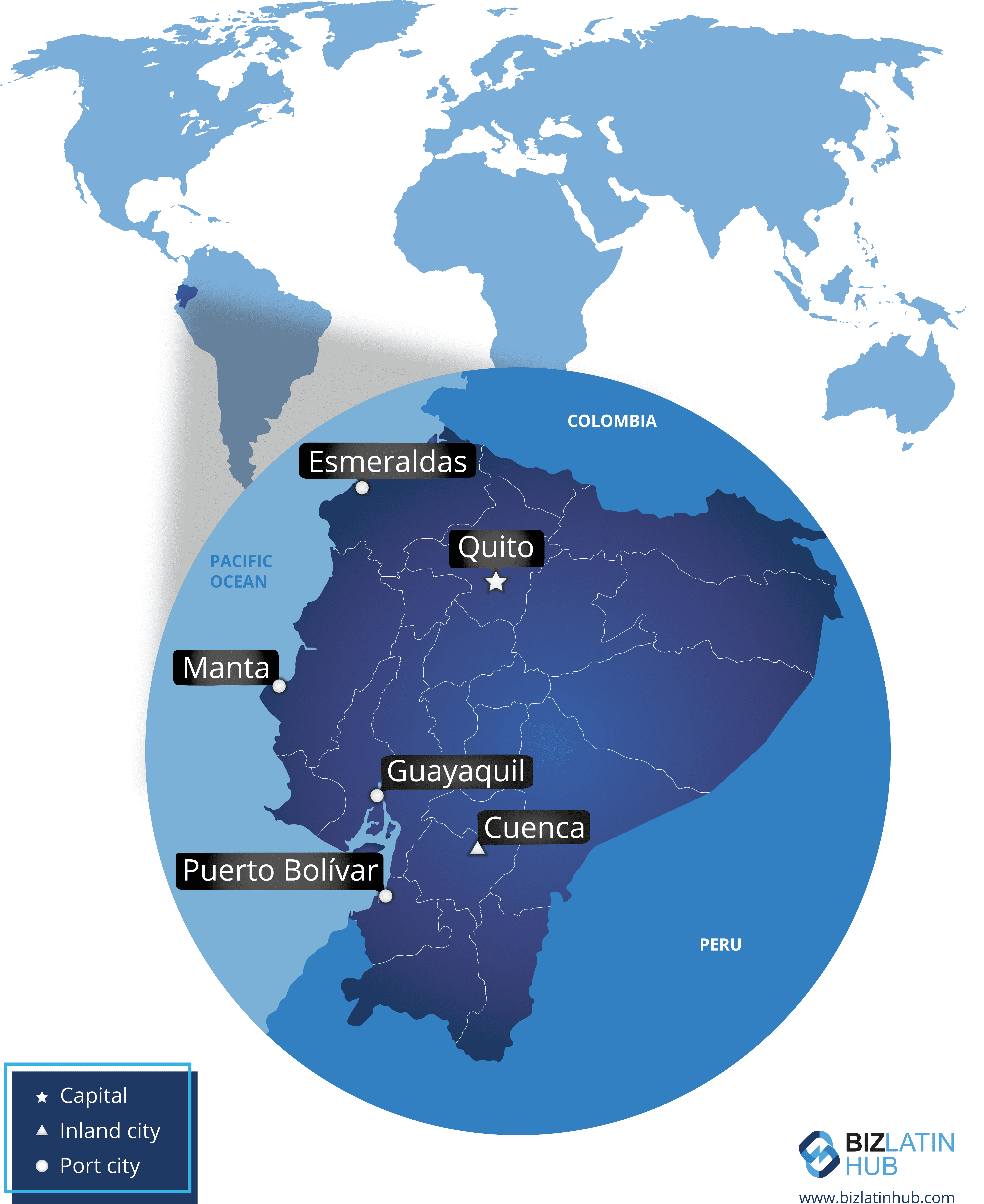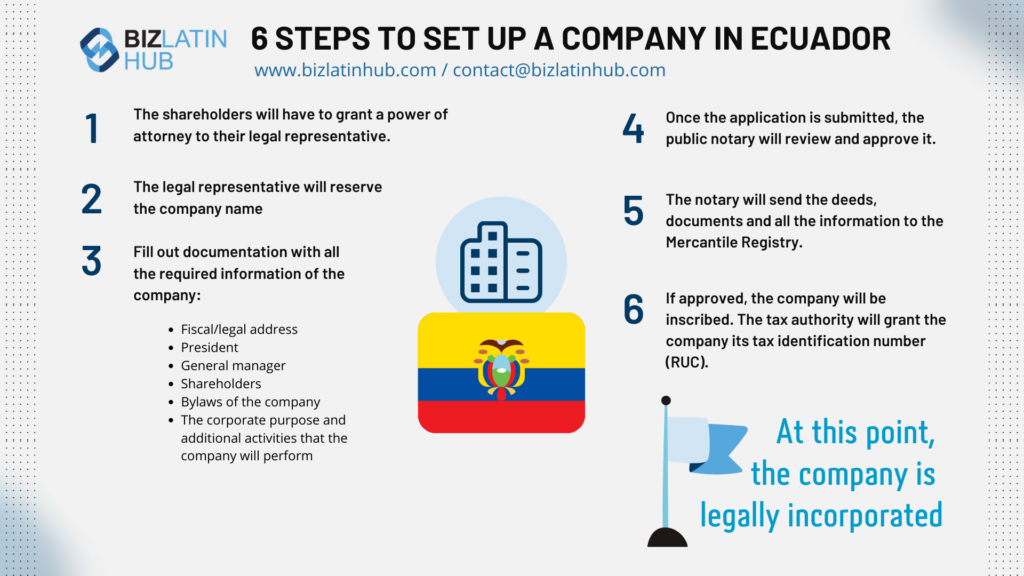Looking to set up a company in Ecuador? Sometimes it can be hard to find quality information. Much of the information online is incomplete or incomprehensible, and will most certainly be in Spanish.

Incorporating a company in Ecuador can come with a few challenges, but they can be easily overcome by working with local partners who have experience doing business in Ecuador.
Compared to some other countries in the region, corporate law in Ecuador is relatively simple. With due diligence and proper strategic thinking, it is possible for companies in many different commercial sectors to succeed.
With that in mind, we have prepared a legal summary of everything you need to know when incorporating a company in Ecuador. Crucially, all the information is provided in English. Before detailing the key steps of company formation in Ecuador, we will provide some characteristics that explain why this is a good place to do business. Ecuador’s economy has performed well in recent years, and continued to attract significant levels of foreign investment.
Ecuador ranks as the eighth largest economy among Latin American countries, boasting a gross domestic product (GDP) valued at $106 million in 2021 (all figures denominated in USD).
Notably, it is also a leading destination for foreign direct investment (FDI) in the region, having received inflows totaling over $630 million in 2021. However, this amount marks a significant decline compared to 2020, which recorded FDI inflows of $1 billion!
Table of Contents
How to Set Up a Company in Ecuador: Key Details
This is some basic information you will find useful when setting up a company in Ecuador.
- In Ecuador, 100% foreign ownership is allowed, so you do not need an Ecuadorian partner.
- The minimum number of shareholders is one (1) and they can be natural persons, legal entities, or both.
- All legal entities in Ecuador need a General Manager or CEO. They have to be Ecuadorian or a foreigner with a valid resident visa.
- Some entities need to appoint a or Chairman. Both, the President and the CEO can be the legal representatives, individually or combined.
- Limited liability (R.L), Corporations (S.A.) and Simplified Stock Companies (S.A.S) are the most common types of entities in Ecuador.
- Minimum capital: Limited liability USD$400, Corporations unlimited liability USD$800, and Simplified Stock Companies USD$0.
- All legal entities in Ecuador require a fiscal address.
- The currency in Ecuador is US$ Dollars.
Read on for an overview of the company formation process in Ecuador broken down into key steps.

Company Formation Process
Investors seeking to set up a company in Ecuador can choose to establish both limited liability and unlimited liability companies. This can be done online or by following the normal “manual” process. We recommend using the online process because it is a lot easier and faster, and transfers a significant amount of the workload to the authorities.
Steps to Follow to Set Up Your Business in Ecuador
The first step towards company incorporation is ensuring that the shareholders grant power of attorney to their legal representative, giving him/her permission to set up the company in Ecuador on their behalf.

The legal representative, usually an attorney, will then start the setup process. If completing the process online, the legal representative will reserve the company name, and fill out documentation with all the required information about the company: fiscal/legal address, president, general manager, name of the shareholders, and how much each shareholder holds in the company.
This application also asks for completed company bylaws, the corporate purpose, and a description of activities that the company will perform.
Once the application is submitted, the public notary will review and approve it. Then, the President, General Manager, and the shareholders will have to sign the deed and the corresponding documents.
The notary will then send the deeds, documents, and all the information to the Mercantile Registry for review. If the documents are approved, the Mercantile Registry will then inscribe the company. This is the last step when setting up a company in Ecuador.
Once the company has been successfully set up, the tax authority will grant it a tax identification number (RUC).
4 Additional Obligations to Set Up a Company in Ecuador
At this point, the company is legally incorporated in Ecuador. However, before you begin commercial activities, you must meet some other obligations:
- Step 1: Open a corporate bank account and deposit the company’s minimum capital.
- Step 2: Create an account with the ‘Superintendencia de Compañías’.
- Step 3: Register the company with the Social Security Agency (IESS).
- Step 4: Pay the municipal patent and get the license of economic activities.
Common Questions When Forming a Company in Ecuador
Answers to some of the most common questions we get asked by our clients.
Yes, a business can be 100% foreign owned by either legal persons (“legal entities”) or natural persons (“individuals”).
Registering a company in Ecuador takes 5 weeks.
S.A.S means “Sociedad por acciones Simplificada”, which translates to “Joint Stock Company.” This is a type of commercial company with legal personality and assets independent from those of its owners. Shareholders are liable only up to the amount of their respective contributions corresponding to the integration of the shares they subscribe to or acquire. Sharedholders are not liable for labor, tax, or any other type of obligations incurred by the company beyond its contribution, except in the event that the legal personality of the company is declared unenforceable.
SRL in Ecuador stands for “Sociedad de Responsabilidad Limitada,” which translates to Limited Liability Company in English. This legal entity operates independently from its shareholders, offering them limited liability. SRL companies are prevalent due to their simplified requirements, making them a popular choice for business structures.
In Ecuador the “S.R.L” (Sociedad de Responsabilidad Limitada) is limited liability entity type.
A. Number of shareholders: A SAS can have from one to an unlimited number of shareholders, while an S.R.L must have at least two partners and a limit of fifteen.
B. Shareholders’ General Meeting: A SAS may freely choose the organizational structure of the company; however, the General Assembly of Shareholders is usually the most used management body, and its resolutions are adopted with the favorable vote of half plus one of the shareholders present at the meeting. While in a S.R.L. the General Meeting of Partners is the mandatory supreme body of the company, and its resolutions are adopted by an absolute majority of the attendees.
C. Board of directors: In a SAS, it is not mandatory to establish a board of directors, but if created, it can be made up of one or more administrators according to the company’s bylaws. On the other hand, in a S.R.L. the board of directors is mandatory and can be made up of two or more administrators.
D. Legal representative: In a SAS the shareholders can remove or replace the legal representative of the company without the need to invoke any statutory or legal causes. While in a S.R.L. the legal representatives must comply with certain legal obligations, under penalty of being removed or revoked from their positions.
E. Duration: Both SAS and R.L can have an unlimited duration.
F. Responsibility of the shareholders: In both legal vehicles, the shareholders are jointly and severally liable for the debts of the company up to the amount of their contributions. However, in a S.A.S. shareholders can establish in the company’s bylaws the unlimited liability of its members.
G. Social capital: SAS has no minimum capital requirement for its incorporation, while an RL requires a minimum capital.
H. Regulation: An SAS is subject to easier regulation than an S.R.L. since it has fewer formalization and disclosure requirements.
Do You Want to Form a Company in Ecuador?
If you have any questions or inquiries about how to set up a company in Ecuador, our local Ecuadorian business experts have created a company formation presentation.
We hope it helps! If you have any more questions about how to incorporate your company in Ecuador, please do not hesitate to contact us now. Our Biz Latin Hub team in Ecuador includes local and expat professionals who have the knowledge and expertise to support you throughout the process.

The information provided here within should not be construed as formal guidance or advice. Please consult a professional for your specific situation. Information provided is for informative purposes only and may not capture all pertinent laws, standards, and best practices. The regulatory landscape is continually evolving; information mentioned may be outdated and/or could undergo changes. The interpretations presented are not official. Some sections are based on the interpretations or views of relevant authorities, but we cannot ensure that these perspectives will be supported in all professional settings.